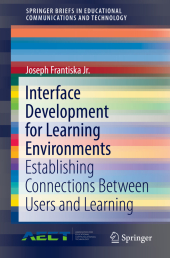 Neuerscheinungen 2019Stand: 2020-02-01 |
Schnellsuche
ISBN/Stichwort/Autor
|
Herderstraße 10
10625 Berlin
Tel.: 030 315 714 16
Fax 030 315 714 14
info@buchspektrum.de |

Joseph Frantiska
Interface Development for Learning Environments
Establishing Connections Between Users and Learning
1st ed. 2019. 2019. xi, 89 S. 10 SW-Abb. 235 mm
Verlag/Jahr: SPRINGER, BERLIN; SPRINGER INTERNATIONAL PUBLISHING 2019
ISBN: 3-03-014481-X (303014481X)
Neue ISBN: 978-3-03-014481-4 (9783030144814)
Preis und Lieferzeit: Bitte klicken
This brief will examine and explore some tools and techniques that can be used to develop interfaces for learning environments. Interface design has been a topic in software engineering for many years. The advent of graphical user interfaces has created many remedies and challenges for the software engineer. In recent years with an increased emphasis in educational technology, instructional designers are also included in this arena. The interface can be a driver in terms of a learning environment´s ability to engage a student. It can also provide a point of information exchange and therefore learning between the student and the environment´s software. Thus, the issue of an interface is vital to the success of a learning environment. This brief will produce a variety of interfaces for various environments to allow the designer to contrast and compare them based upon the required purpose. The designer will have a toolkit filled with tools and techniques which will allow for interfaces that will engage the student and facilitate their learning. The primary audiences are K-12 and post-secondary educators who desire to create digital media based educational materials.
Background and Significance
User Interface Design
Hypertext
Animation
Assessment
Understand the Audience
Define the Inputs
Define what processing occurs
Define the outputs
Cognitive Underpinnings
Chunking Implications for User Interface Design
Dual Coding
Dissonance Theory
Learning Taxonomies
Cognitive learning taxonomy
Affective learning taxonomy
Psychomotor learning taxonomy
Combining taxonomies
Presentation Sequencing
Elaboration Theory
Learning Hierarchies
Prototyping
Storyboarding
Navigation Patterns
Random Design
Structured Designs
Selecting an Appropriate Design
Multimedia: It´s Implementation and Usage
Images
Image file compression
Lossless Compression
Lossy Compression
Raster formats
Interlacing
GIF
Design issues with GIFs
JPEG
Design Issues with JPEGs
TIFF
RAW
PNG
BMP
PPM, PGM, PBM, PNM
Vector formats
CGM
SVG
Motion Pictures / Animation
Sound Files
Uncompressed Format
Compressed Formats
Lossy Compression
Lossless Compression
Text and Message Design
Their Combination
Modality Principle
Redundancy principle
Implications for Multimedia Design Limits
The Case for Adding On-Screen Text to Narrated Animations - The learning preference principle
The Case Against Adding On-Screen Text to Narrated Animations
Other Principles
Navigation Patterns
Random Design
Structured Designs
Summary / Conclusion
Joseph J. Frantiska Jr. is a contributing faculty member at Walden University. He has undergraduate degrees in mathematics, business, software engineering and artificial intelligence along with graduate degrees in computer science and business administration. He possesses a doctorate in education from the University of Massachusetts at Amherst. Prior to entering the field of instructional technology, he spent over 25 years in industry as a systems and software engineer with experience in all aspects of the software and system development lifecycles generating more than 20 technical publications. He has taught at the college level for over twenty five years in both educational technology and computer science in both online and face-to-face environments.


